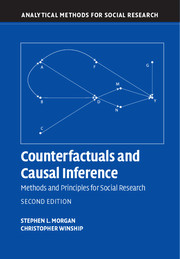Book contents
- Frontmatter
- Dedication
- Contents
- List of Figures
- List of Tables
- Acknowledgments for First Edition
- Acknowledgments for Second Edition
- I Causality and Empirical Research in the Social Sciences
- II Counterfactuals, Potential Outcomes, and Causal Graphs
- III Estimating Causal Effects by Conditioning on Observed Variables to Block Back-Door Paths
- 4 Models of Causal Exposure and Identification Criteria for Conditioning Estimators
- 5 Matching Estimators of Causal Effects
- 6 Regression Estimators of Causal Effects
- 7 Weighted Regression Estimators of Causal Effects
- IV Estimating Causal Effects When Back-Door Conditioning Is Ineffective
- V Estimation When Causal Effects Are Not Point-Identified by Observables
- VI Conclusions
- References
- Index
4 - Models of Causal Exposure and Identification Criteria for Conditioning Estimators
Published online by Cambridge University Press: 05 December 2014
- Frontmatter
- Dedication
- Contents
- List of Figures
- List of Tables
- Acknowledgments for First Edition
- Acknowledgments for Second Edition
- I Causality and Empirical Research in the Social Sciences
- II Counterfactuals, Potential Outcomes, and Causal Graphs
- III Estimating Causal Effects by Conditioning on Observed Variables to Block Back-Door Paths
- 4 Models of Causal Exposure and Identification Criteria for Conditioning Estimators
- 5 Matching Estimators of Causal Effects
- 6 Regression Estimators of Causal Effects
- 7 Weighted Regression Estimators of Causal Effects
- IV Estimating Causal Effects When Back-Door Conditioning Is Ineffective
- V Estimation When Causal Effects Are Not Point-Identified by Observables
- VI Conclusions
- References
- Index
Summary
In this chapter, we present the basic conditioning strategy for the estimation of causal effects. We first provide an account of the two basic implementations of conditioning – balancing the determinants of the cause of interest and adjusting for other causes of the outcome – using the language of “back-door paths.” After explaining the unique role that collider variables play in systems of causal relationships, we present what has become known as the back-door criterion for sufficient conditioning to identify a causal effect. To bring the back-door criterion into alignment with related guidance based on the potential outcome model, we then present models of causal exposure, introducing the treatment assignment and treatment selection literature from statistics and econometrics. We conclude with a discussion of the identification and estimation of conditional average causal effects by conditioning.
Conditioning and Directed Graphs
In Section 1.5, we introduced the three most common approaches for the estimation of causal effects, using language from the directed graph literature: (1) conditioning on variables that block all back-door paths from the causal variable to the outcome variable, (2) using exogenous variation in an appropriate instrumental variable to isolate covariation in the causal variable and the outcome variable, and (3) establishing the exhaustive and isolated mechanism that intercepts the effect of the causal variable on the outcome variable and then calculating the causal effect as it propagates through the mechanism.
- Type
- Chapter
- Information
- Counterfactuals and Causal InferenceMethods and Principles for Social Research, pp. 105 - 139Publisher: Cambridge University PressPrint publication year: 2014

